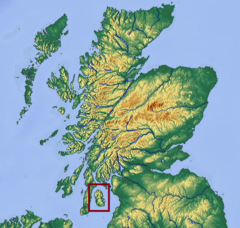Isle of Arran
| Isle of Arran | |
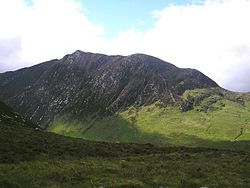 Caisteal Abhail, Arran | |
|---|---|
| Main town: | Brodick |
| Location | |
| Grid reference: | NR950359 |
| Area: | 167 sq miles |
| Highest point: | Goat Fell: 2,867 feet |
| Data | |
| Population: | 5,058 (2001) |
Arran is the largest island of Buteshire and the largest in the Firth of Clyde. Although commonly associated with the Hebrides, with which it shares many cultural and physical similarities, it lies inside the reach of the Kintyre peninsula and so might be better classed simply amongst the islands of the Firth.
Arran is a mountainous island, full of wild, beautiful scenery, but sparsely populated. For the rich variety of rock forms here it has been described as a "geologist's paradise".[1]
Remains are found on the island from the Neolithic and later prehistoric periods. From the 6th century on, Gaelic-speaking peoples from Ireland colonised the island and it became a centre of religious activity. During the Viking Age, Arran became a possession of the Norse adventurers and later the property of the Norwegian crown before being formally absorbed by the kingdom of Scotland in the thirteenth century. The 19th century "clearances" led to significant reductions in population and the end of the Gaelic language and way of life.
The economy and population have recovered in recent years, the main industry being tourism. There is diversity of wildlife, including three species of tree endemic to the area.
Name of the island
As with most of the islands of the Hebrides and the Clyde, at least four languages have been spoken by the occupants since the Iron Age, and many of the names of these islands have more than one possible meaning as a result. Arran is therefore not unusual in that the derivation of the name is far from clear.
Mac an Tàilleir (2003) states that "it is said to be unrelated to the name Aran in Ireland" (which means "kidney shaped"). Haswell-Smith offers a British language (Brythonic) derivation and a meaning of "high place" which at least corresponds with the geography, as Arran is significantly loftier than all the land that immediately surrounds it along the shores of the Firth of Clyde.[1] Any other Brythonic place names that may have existed were later replaced as the Gaels spread from Ireland and their adjacent kingdom of Dál Riata.
During the Viking Age the island, along with the vast majority of the Scottish islands, became the property of the Norwegians, at which time it may have been known as "Herrey" or "Hersey". As a result of this Norse influence, many current place names on Arran are of Viking origin.[2]
Ferries

Two Caledonian MacBrayne ferries sail between Arran and Ayrshire, one from Brodick to Ardrossan and the second (in summertime only) from Lochranza to Claonaig.[3] Summer day trips are also available on board the paddle steamer Waverley and a summertime service operated by a local resident connects Lamlash to the neighbouring Holy Isle. No regular ferry sails any more for the Isle of Bute nor for Great Cumbrae, leaving the county disconnected from itself.
Geography and geology
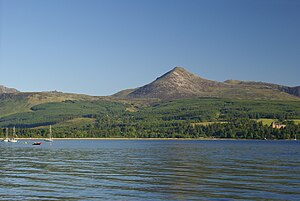
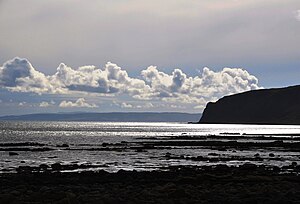
The island lies in the Firth of Clyde between Ayr and Kintyre. The profile of the north Arran hills as seen from the Ayrshire coast is a well-known sight referred to as the "Sleeping Warrior" from its resemblance to a resting human figure.[4][5] The highest of these hills is Goat Fell at 2,867 feet.[6] Three other mountains rise in the north east; Caisteal Abhail, Cìr Mhòr and Beinn Tarsuinn. Bheinn Bharrain is the highest peak in the northwest at 2,365 feet.[7] The largest valley on the island is Glen Iorsa to the west, whilst narrow Glen Sannox (Irish: Gleann Shannaig) and Glen Rosa (Irish: Gleann Ròsa) to the east surround Goat Fell. The terrain to the south is less mountainous, although a considerable portion of the interior lies above 1,150 feet and the summit of A' Chruach climbs to 1,680 feet.[1]
The island is sometimes referred to as "Scotland in miniature", as it is divided into "Highland" and "Lowland" areas by the Highland Boundary Fault, which runs northeast to southwest across Scotland.[8] The island is a popular destination for geologists, who come to see intrusive igneous landforms such as sills and dykes as well as sedimentary and metasedimentary rocks ranging in age from Precambrian to Mesozoic.

Most of the interior of the northern half of the island is taken up by a large granite batholith that was created by substantial volcanic activity around 60 million years ago in the Tertiary period. There is an older outer ring of coarse granites and an inner core of finer grained material. Sedimentary rocks dominate the southern half of the island, especially Old and New Red Sandstone. Some of these sandstones contain fulgurites - pitted marks that may have been created by Permian lightning strikes.[8] Sand dunes are preserved in Permian sandstones near Brodick, there are localised outcrops of Triassic rocks and even a rare example of Cretaceous chalk.[9][10] During the nineteenth century barytes was mined near Sannox. First discovered in 1840, nearly 5,000 tons were produced between 1853 and 1862. The mine was closed by the 11th Duke of Hamilton on the grounds that it "spoiled the solemn grandeur of the scene" but was reopened after the First World War and operated until 1938 when the vein ran out.[11][12]
Visiting in 1787, the geologist James Hutton found his first example of an unconformity to the north of Newton Point near Lochranza, which provided evidence for his Plutonist theories of uniformitarianism and about the age of the Earth. This spot is one of the most famous places in the study of geology.[13][14]
The Pleistocene glaciations almost entirely covered Scotland in ice and Arran's highest peaks may have been nunataks at this time.[8] After the last retreat of the ice at the close of the Pleistocene epoch sea levels were up to 230 feet lower than at present and it is likely that around 14,000 ago the island was connected to mainland Great Britain.[15] Sea level changes and the isostatic rise of land makes charting post-glacial coastlines a complex task, but it is evident that the island is ringed by post glacial raised beaches.[16]
King's Cave on the south west coast is an example of an emergent landform on such a raised beach. This cave, which is over 100 feet long and up to 50 feet high, lies well above the present day sea level.[17][18] (This cave is one of several associated with the legend of Robert the Bruce and the spider.)
There are tall sea cliffs to the north east including large rock slides under the heights of Torr Reamhar and at Scriden (An Scriodan) at the far north end of the island.[19]
Villages
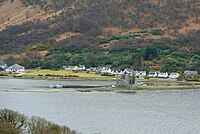
Arran's villages are mainly found around the shoreline. Brodick (Old Norse for "broad bay") is the site of the ferry terminal, several hotels, and the majority of shops. Brodick Castle is a seat of the Dukes of Hamilton. Lamlash, however, is the largest village on the island and in 2001 had a population of 1,010 compared to Brodick's 621.
Other villages include Lochranza in the north, Corrie in the north east, Blackwaterfoot in the south west, Kildonan in the south and Whiting Bay in the south east. Catacol lies just down the road from Lochranza.
Surrounding islands
Arran has three smaller satellite islands: Holy Isle lies to the east opposite Lamlash, Pladda is located off Arran's south coast and tiny Hamilton Isle lies just off Clauchlands Point a mile north of Holy Isle. Eilean na h-Àirde Bàine off the south west of Arran at Corriecravie is a skerry connected to Arran at low tide.
Other islands in the Firth of Clyde include Bute, Great Cumbrae, Little Cumbrae and Inchmarnock, all parts of Buteshire.
History
Prehistory

Arran has a particular concentration of early Neolithic Clyde Cairns, a form of Gallery grave. The typical style of these structures is that of a rectangular or trapezoidal stone and earth mound that encloses a chamber lined with larger stone slabs. Pottery and bone fragments found inside the chambers suggest they were used for internment and some have forecourts, which may have been an area for public display or ritual. There are two good examples in Monamore Glen east of the village of Lamlash,[20] and similar structures called the Giant's Graves above Whiting Bay. There are numerous standing stones dating from prehistoric times, including six stone circles on Machrie Moor.[21]
Several Bronze Age sites have been excavated, including "Ossian's Mound" near Clachaig and a cairn near Blackwaterfoot that produced a bronze dagger and a gold fillet.[22] Torr a' Chaisteal Dun in the south west near Sliddery is the ruin of an Iron Age fortified structure dating from about 200 AD. The original walls would have been 10 feet or more thick and enclosed a circular area about 45 feet in diameter.[23]
Gaels, Vikings and the mediæval era
An ancient Irish poem called Agalllamh na Senorach, first recorded in the 13th century, describes the attractions of the island.
- Arran of the many stags
- The sea strikes against her shoulders,
- Companies of men can feed there,
- Blue spears are reddended among her boulders.
- Merry hinds are on her hills,
- Juicy berries are there for food,
- Refreshing water in her streams,
- Nuts in plenty in the wood.[24]
The monastery of Aileach founded by St Brendan in the 6th century may have been on Arran and St Molaise was also active, with Holy Isle being a centre of his activities.[25] The caves below Keil Point contain a slab which may have been an ancient altar. This stone has two petrosomatoglyphs on it, the prints of two right feet, which legend says are Columba's.[26]
In the 11th century Arran became part of the Suðreyjar ("South Isles") of the Kingdom of Mann and the Isles, but after the death of Godred Crovan in 1095 all the isles came under the direct rule of Magnus III of Norway. Lagman (1103–1104) restored local rule. After the death of Somerled, Arran and Bute were ruled by his son Angus.[27] In 1237, the Scottish isles broke away completely from the Isle of Man and became an independent kingdom, before being ceded to the Scottish crown in 1266 by the Treaty of Perth.
A substantial Viking grave has been discovered near King's Cross south of Lamlash, containing whalebone, iron rivets and nails, fragments of bronze and a 9th century bronze coin, and another grave of similar date nearby yielded a sword and shield.[28] Arran was also part of the mediæval Bishopric of Sodor and Man.
On the opposite side of the island near Blackwaterfoot is the King's Cave (see above) where Robert the Bruce is said to have taken shelter in the 14th century.[29] Bruce returned to the island in 1326, having earlier granted lands to Fergus MacLouis for assistance rendered during his time of concealment there. Brodick Castle played a prominent part in the island's mediæval history. Probably dating from the 13th century, it was captured by English forces during the Wars of Independence before being taken back by Scottish forces in 1307. It was badly damaged by action from English ships in 1406 and sustained an attack by John of Islay, the Lord of the Isles in 1455. Originally a seat of the Clan Stewart of Menteith it passed to the Boyd family in the 15th century.[30][31] For a short time during the reign of King James V in the 16th century the Isle of Arran was under the regency of Robert Maxwell, 5th Lord Maxwell.[32]
Modern era
In 1503, James, Duke of Hamilton was created Earl of Arran as a reward for his service to King James IV of Scotland and his help in arranging the King's marriage to Princess Margaret Tudor of England. The local economy for much of this period was based on the run rig system, the basic crops being oats, barley and potatoes and the population slowly grew to about 6,500.
In the early 19th century Alexander, tenth Duke of Hamilton (1767–1852) embarked on a programme of clearances that had a devastating effect on the island's population. These improvements typically led to the land's being rented out to as many as twenty-seven families being converted into a single farm. In some cases, alternative land was promised in Canada for each adult emigrant male. In April 1829, for example, 86 islanders boarded the brig Caledonia for the two-month journey, half their fares being paid for by the Duke. The writer James Hogg wrote: "Ah! Wae's me. I hear the Duke of Hamilton's crofters are a' gaun away, man and mother's son, frae the Isle o' Arran. Pity on us!".[33] A memorial has been built on the shore at Lamlash, paid for by a Canadian descendant of the emigrants.[34][35]
Natural history
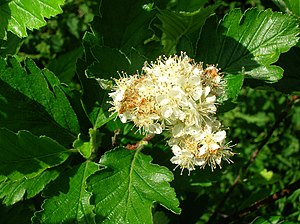
The island has three endemic species of tree, the Arran Whitebeams.[36] These trees are the Scottish or Arran Whitebeam (Sorbus arranensis), the Bastard Mountain Ash or Cut-leaved Whitebeam (Sorbus pseudofennica)[37] and the Catacol Whitebeam (Sorbus pseudomeinichii). If rarity is measured by numbers alone they are amongst the most endangered tree species in the world. They are protected in Glen Diomhan off Glen Catacol, at the north end of the island by a partly fenced off Nature Reserve, and are monitored by staff from Scottish Natural Heritage. Only 236 Sorbus pseudofennica and 283 Sorbus arranensis were recorded as mature trees in 1980. They are typically trees of the mountain slopes, close to the tree line. However, they will grow at lower altitudes, and are being preserved within Brodick Country Park.
Over 200 species of bird have been recorded on Arran including black guillemot, Eider duck, peregrine falcon and the Golden Eagle.[38] In 1981 there were 28 ptarmigan on Arran, but in 2009 it was reported that extensive surveys had been unable to record any.[39][40] Similarly, the red-billed chough no longer breeds on the island.[41]
Red deer are numerous on the northern hills, and there are populations of red squirrel, badger, otter, adder and common lizard. Offshore there are harbour porpoises, basking sharks and various species of dolphin.[38]
References
- ↑ 1.0 1.1 1.2 Haswell-Smith, Hamish (2004) The Scottish Islands. Edinburgh. Canongate. ISBN 1841954543
- ↑ Downie, R. Angus (1933) All About Arran. Glasgow. Blackie and Son
- ↑ "Arran: Getting there/around" Caledonian MacBrayne. Retrieved 17 July 2009.
- ↑ Keay & Keay (1994) p. 42 refer to "the profile of the 'Sleeping Warrior' of Arran as seen from the Clyde Coast". Various websites claim the phrase refers to single hills, none of which individually resemble a reclining human figure.
- ↑ "Arran Page 1" hughspicer.fsnet.co.uk. Retrieved 22 February 2009.
- ↑ Downie (1933) p. 2.
- ↑ Johnstone et al. (1990) pp. 223-26.
- ↑ 8.0 8.1 8.2 McKirdy et al. (2007) pp. 297- 301.
- ↑ McKirdy et al. (2007) pp. 143, 144, 149.
- ↑ The implications of this small chalk outcrop are considerable. It suggests that like much of southern England, Scotland once had considerable deposits of this material that have been subsequently eroded away, although there is no clear-cut evidence of this. See McKirdy et al. (2007) p. 298.
- ↑ "Corrie". Undiscovered Scotland. Retrieved 16 January 2010.
- ↑ Hall (2001) p. 28
- ↑ Keith Montgomery (2003). "Siccar Point and Teaching the History of Geology" (pdf). University of Wisconsin. http://nagt.org/files/nagt/jge/abstracts/Montgomery_v51n5.pdf. Retrieved 26 March 2008.
- ↑ "Hutton's Unconformity - Lochranza, Isle of Arran, UK - Places of Geologic Significance on Waymarking.com". Waymarking.com. http://www.waymarking.com/waymarks/WM3F65. Retrieved 20 October 2008. The site was not sufficiently convincing for him to publish his find until the discovery of a second site near Jedburgh.
- ↑ Murray (1973) pp. 68-69.
- ↑ McKirdy et al. (2007) p. 28.
- ↑ Andrew Rogie. "Geology of Arran". http://www.virtual-geology.info/vft/2004-andy/Arran.htm. Retrieved 2008-11-09.
- ↑ Downie (1933) pp. 70-71.
- ↑ Downie (1933) p. 19 records that the Scriden rocks fell "it is said, some two hundred years ago, with a concussion that shook the earth and was heard in Bute and Argyllshire".
- ↑ Noble (2006) pp. 104–08.
- ↑ "Machrie Moor Stone Circles". Undiscovered Scotland. Retrieved 18 July 2009.
- ↑ Downie (1933) pp. 29–30.
- ↑ "Torr a' Chaisteal Dun". Undiscovered Scotland. Retrieved 18 July 2009.
- ↑ Downie (1933) pp. 34–35.
- ↑ Downie (1933) pp. 35–37.
- ↑ Beare (1996) p. 26.
- ↑ Murray (1973) p. 167–71.
- ↑ Downie (1933) pp. 38–40.
- ↑ "King's Cave: The cave at Drummadoon". showcaves.com. Retrieved 18 July 2009.
- ↑ Downie (1933) pp.42–43. He states that the 1406 attack led by the Earl of Lennox "utterly destroyed" the structure.
- ↑ Coventry (2008) pp. 53, 255, 551.
- ↑ Taylor (1887) vol 2 p. 3.
- ↑ Quoted by Haswell Smith (2004) p. 12.
- ↑ Mackillop, Dugald "The History of the Highland Clearances: Buteshire - Arran" electricscotland.com. Retrieved 18 July 2009.
- ↑ "Lagantuine - Isle of Arran, Ayrshire UK" waymarking.com. Retrieved 18 July 2009.
- ↑ Johnston, Ian (15 June 2007). "Trees on Arran 'are a whole new species'". The Scotsman (Edinburgh). http://news.scotsman.com/scitech.cfm?id=936532007. Retrieved 18 June 2007.
- ↑ Donald Rodger, John Stokes & James Ogilve (2006). Heritage Trees of Scotland. The Tree Council. p. 58. ISBN 0-904853-03-9.
- ↑ 38.0 38.1 "Arran Wildlife". arranwildlife.co.uk. Retrieved 18 July 2009.
- ↑ "Iconic Birds at Risk". Sunday Herald (Glasgow). 1 February 2009. Available as Ptarmigan disappearing from southern Scotland
- ↑ Downie (1933) p. 132 includes the Ptarmigan in a list of birds no longer extant on the island at that time including the red kite, hobby, white-tailed sea eagle, hen harrier and capercaillie.
- ↑ "A6.102a Chough Pyrrhocorax pyrrhocorax (breeding)" (pdf) JNCC. Retrieved 1 August 2009.
Books
- Beare, Beryl (1996) Scotland. Myths & Legends. Avonmouth. Parragon. ISBN 0752516949
- Coventry, Martin (2008) Castles of the Clans. Musselburgh. Goblinshead. ISBN 9781899874361
- Downie, R. Angus (1933) All About Arran. Glasgow. Blackie and Son.
- Hall, Ken (2001) The Isle of Arran. Catrine. Stenlake Publishing. ISBN 9781840331356
- Holmer, N. (1957) The Gaelic of Arran. Dublin. Dublin Institute for Advanced Studies.
- Johnstone, Scott; Brown, Hamish; and Bennet, Donald (1990) The Corbetts and Other Scottish Hills. Edinburgh. Scottish Mountaineering Trust. ISBN 0907521290
- Keay, J. & Keay, J. (1994) Collins Encyclopaedia of Scotland. London. HarperCollins. ISBN 0002550822
- McKirdy, Alan Gordon, John & Crofts, Roger (2007) Land of Mountain and Flood: The Geology and Landforms of Scotland. Edinburgh. Birlinn. ISBN 9781841583570
- Murray, W H (1973) The Islands of Western Scotland. London. Eyre Methuen. SBN 413303802
- Noble, Gordon (2006) Neolithic Scotland: Timber, Stone, Earth and Fire. Edinburgh University Press. ISBN 0748623388
- Ó Dochartaigh, C. (1997) Survey of the Gaelic Dialects of Scotland. Dublin. Dublin Institute for Advanced Studies.
- Taylor, J. (1887) Great Historic Families of Scotland vol 2. London. J.S. Virtue & Co.
Outside links
| ("Wikimedia Commons" has material about of Arran Isle of Arran) |
- Information on the Arran Coastal Way long distance path
- Visitor's guide with news, events, transport and accommodation.
- Arran seen from space, NASA
- The Isle of Arran Heritage Museum
- The Arran Banner Arran's local newspaper
- The Sleeping Warrior on Flickr
- Arran.info The Isle of Arran Interactive Guide
